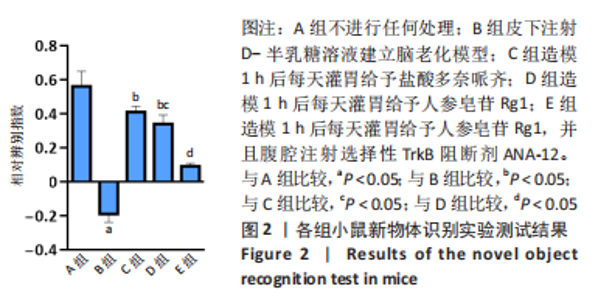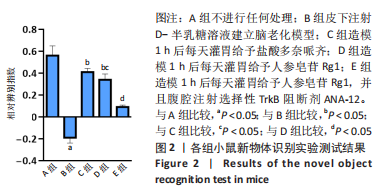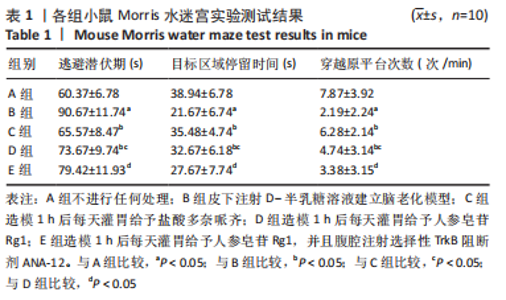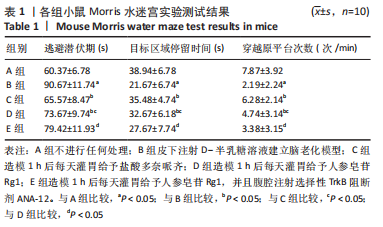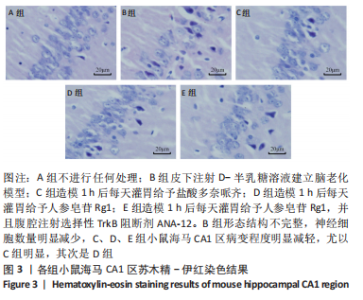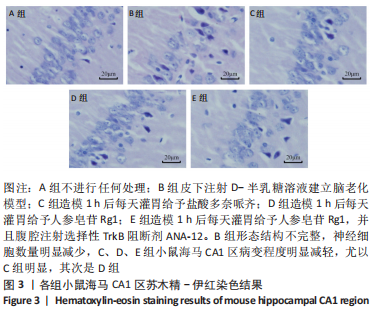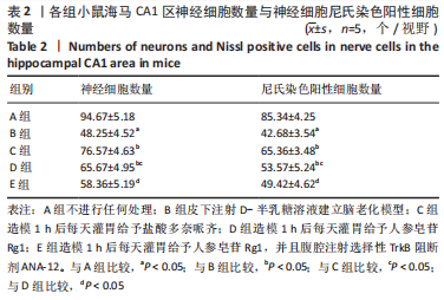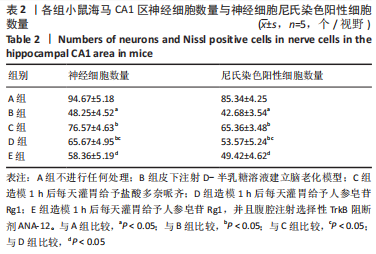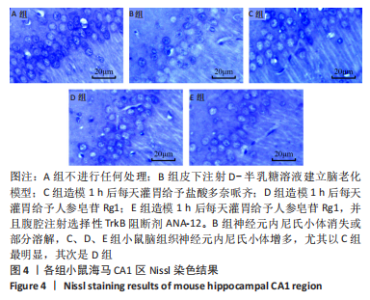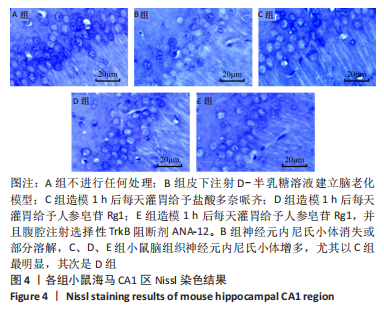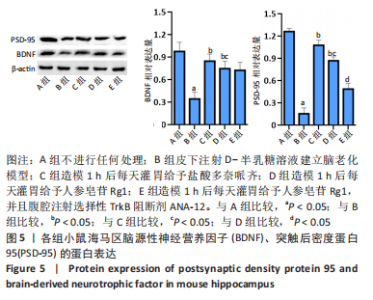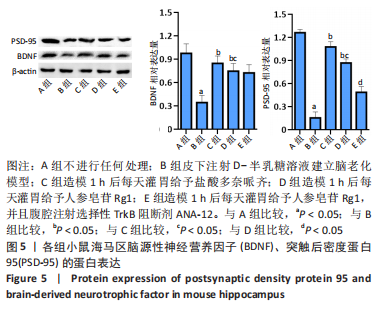Chinese Journal of Tissue Engineering Research ›› 2023, Vol. 27 ›› Issue (28): 4487-4493.doi: 10.12307/2023.556
Previous Articles Next Articles
Effect of ginsenoside Rg1 on learning and memory ability of brain aging mice induced by D-galactose
Yang Yazhu1, 2, Du Juan3, Qu Haifeng1, Li Jianmin1, 2, Zhang Yuxin3, Liu Junjie1, 2
- 1Department of Clinical Medicine, 3Department of Basic Medicine, North China University of Science and Technology, Tangshan 063000, Hebei Province, China; 2Department of Neurosurgery, Affiliated Hospital of North China University of Science and Technology, Tangshan 063000, Hebei Province, China
-
Received:2022-06-23Accepted:2022-08-08Online:2023-10-08Published:2023-01-29 -
Contact:Liu Junjie, Master, Lecturer, Attending physician, Department of Clinical Medicine, North China University of Science and Technology, Tangshan 063000, Hebei Province, China; Department of Neurosurgery, Affiliated Hospital of North China University of Science and Technology, Tangshan 063000, Hebei Province, China -
About author:Yang Yazhu, Department of Clinical Medicine, North China University of Science and Technology, Tangshan 063000, Hebei Province, China; Department of Neurosurgery, Affiliated Hospital of North China University of Science and Technology, Tangshan 063000, Hebei Province, China -
Supported by:Brain Aging and Comprehensive Intervention Research Talent Training Project, No. 381094 (to LJM)
CLC Number:
Cite this article
Yang Yazhu, Du Juan, Qu Haifeng, Li Jianmin, Zhang Yuxin, Liu Junjie. Effect of ginsenoside Rg1 on learning and memory ability of brain aging mice induced by D-galactose[J]. Chinese Journal of Tissue Engineering Research, 2023, 27(28): 4487-4493.
share this article
Add to citation manager EndNote|Reference Manager|ProCite|BibTeX|RefWorks
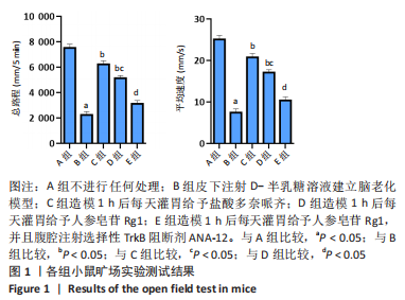
2.1 实验动物数量分析 50只昆明种小鼠全部进入结果分析,无脱落。 2.2 造模小鼠一般状态 A组小鼠好动,反应敏捷,精神状态良好,体毛光滑有光泽;B组小鼠在注射D-半乳糖期间逐渐出现精神萎靡、体毛干枯易落、反应迟钝、自发活动减少等现象。 2.3 各组小鼠旷场实验测试结果 与A组相比,B组小鼠旷场总路程、平均速度减少(P < 0.05),说明其认知能力严重受损;与B组相比,C、D组小鼠旷场总路程、平均速度增加(P < 0.05),说明给予盐酸多奈哌齐和人参皂苷Rg1治疗后,小鼠认知能力得到明显改善;D组小鼠旷场总路程、平均速度少于C组(P < 0.05);与D组相比,E组旷场总路程、平均速度减少(P < 0.05),表明ANA-12明显抑制了人参皂苷Rg1改善认知能力的作用,见图1。"
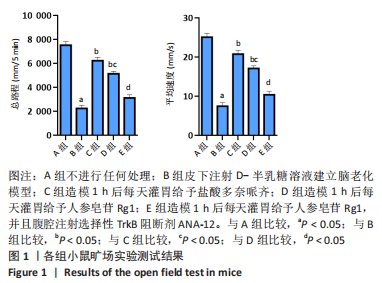
| [1] 林江涛,丁悦敏,张雄.PSD-95与老化相关学习记忆能力下降关系研究进展[J].生物学杂志,2019,36(2):83-85+89. [2] MEDINA JH. Neural, Cellular and Molecular Mechanisms of Active Forgetting. Front Syst Neurosci. 2018;12:3. [3] 付燕,王璐,李雪,杨澎湃,等.有氧运动对D-gal致脑衰老过程中大鼠学习记忆能力及PSD-95的影响[J].武汉体育学院学报,2016, 50(8):87-93. [4] NUMAKAWA T, ODAKA H. Brain-Derived Neurotrophic Factor Signaling in the Pathophysiology of Alzheimer’s Disease: Beneficial Effects of Flavonoids for Neuroprotection. Int J Mol Sci. 2021;22(11):5719. [5] 王子礼,陈显兵,王凤杰,等.头顶一颗珠对衰老大鼠认知及海马BDNF、TrkB的影响[J].中国中西医结合杂志,2020,40(11):1373-1377. [6] 张爽. BDNF基因修饰神经干细胞对Aβ致伤PC12神经元ERK1/2和PSD-95表达的影响[D].佳木斯:佳木斯大学,2016. [7] 杨雄,楚世峰.人参皂苷Rg1和Rb1在神经退行性疾病治疗中的作用[J].神经药理学报,2018,8(6):56-57. [8] GUO Y, WANG L, LU J, et al. Ginsenoside Rg1 improves cognitive capability and affects the microbiota of large intestine of tree shrew model for Alzheimer’s disease. Mol Med Rep. 2021;23(4):291. [9] LOU YX, WANG ZZ, XIA CY, et al. The protective effect of ginsenoside Rg1 on depression may benefit from the gap junction function in hippocampal astrocytes. Eur J Pharmacol. 2020;882:173309. [10] 杜姝,姜岩,刘晶,等.人参皂苷Rg1对癫痫大鼠海马神经元损伤和小胶质细胞活化的影响[J].免疫学杂志,2021,37(3):202-209. [11] YANG C, HE X, ZHAO J, et al. Hepatoprotection by Ginsenoside Rg1 in alcoholic liver disease. Int Immunopharmacol. 2021;92:107327. [12] KIM JH, YI YS, KIM MY, et al. Role of ginsenosides, the main active components of Panax ginseng, in inflammatory responses and diseases. J Ginseng Res. 2017;41(4):435-443. [13] SHAO J, ZHENG X, QU L, et al. Ginsenoside Rg5/Rk1 ameliorated sleep via regulating the GABAergic/serotoninergic signaling pathway in a rodent model. Food Funct. 2020;11(2):1245-1257. [14] 徐谈震. NOX2-NLRP1信号通路在小鼠脑老化损伤中的作用及人参皂苷Rg1的调节作用[D].合肥:安徽医科大学,2019. [15] 沈晓燕.NOX4-NLRP3信号通路在小鼠肾脏老化损伤中的作用及人参皂苷Rg1的调节作用[D].合肥:安徽医科大学,2020. [16] 杨璐萌.人参皂苷Rg1延长C57BL/6J小鼠寿命及延缓脑老化的机制研究[D].福州:福建医科大学,2013. [17] XIANG Y, WANG SH, WANG L, et al. Effects of Ginsenoside Rg1 Regulating Wnt/β-Catenin Signaling on Neural Stem Cells to Delay Brain Senescence. Stem Cells Int. 2019;2019:5010184. [18] 许方方,张珊,李建玲,等.人参皂苷Rb1对阿尔茨海默病模型小鼠术后认知功能、海马内突触后致密蛋白-95及尼氏体表达的影响[J].中西医结合心脑血管病杂志,2022,20(3):440-444. [19] 王冬慧,武鑫,孙宁宁,等.电针干预放射性脑损伤小鼠海马区突触可塑性相关蛋白的表达[J].中国组织工程研究,2021,25(14): 2205-2210. [20] 田勇,周督,邹双忆,等.昆仑雪菊水溶性黄酮提取物对D-半乳糖致衰老小鼠学习记忆障碍的改善作用[J].食品科学,2019,40(1):162-168. [21] 翟春梅,薛迎凤,郭鹏飞,等.白术对D-半乳糖致衰老小鼠学习记忆和抗氧化能力的影响[J].中医药学报,2021,49(7):26-31. [22] 李斌,李佳欣,郝彦伟,等.远志散对阿尔茨海默病模型小鼠学习记忆能力及海马紧密连接蛋白表达的影响[J].中医杂志,2022,63(6): 557-563. [23] 吕静薇.人参皂苷Rg1和Rb1改善航天失重效应与睡眠干扰所致认知功能减退作用及机制研究[D].北京:北京协和医学院,2021. [24] 赵佳佳,杨荷雨,王招娣,等.ANA-12通过靶向阻断BDNF/TrkB信号通路降低大鼠的脊髓炎症和缓解病理性疼痛[J].南方医科大学学报,2022,42(2):232-237. [25] 陈晓禾.海马组织MAD2B过表达对小鼠学习记忆能力影响及机制研究[D].武汉:华中科技大学,2019. [26] Li M, Zhao J, Tang Q, et al. Lamivudine improves cognitive decline in SAMP8 mice: Integrating in vivo pharmacological evaluation and network pharmacology. J Cell Mol Med. 2021;25(17):8490-8503. [27] ZIA A, POURBAGHER-SHAHRI AM, FARKHONDEH T, et al. Molecular and cellular pathways contributing to brain aging. Behav Brain Funct. 2021;17(1):6. [28] LIU N, ZENG L, ZHANG YM, et al. Astaxanthin alleviates pathological brain aging through the upregulation of hippocampal synaptic proteins. Neural Regen Res. 2021;16(6):1062-1067. [29] 赵思琦,杜鹃,屈海峰,等.丰富环境联合褪黑素对SAMP8小鼠学习记忆功能及脑神经细胞凋亡的影响[J].中国组织工程研究, 2023,27(5):701-706. [30] HAIDER S, LIAQUAT L, SHAHZAD S, et al. A high dose of short term exogenous D-galactose administration in young male rats produces symptoms simulating the natural aging process. Life Sci. 2015;124: 110-119. [31] 王钊.生物衰老:研究方法与实验方案[J].遗传,2012,34(11):1364. [32] LU S, ZHANG Y, LI H, et al. Ginsenoside Rb1 can ameliorate the key inflammatory cytokines TNF-α and IL-6 in a cancer cachexia mouse model. BMC Complement Med Ther. 2020;20(1):11. [33] LI X, GUAN J, SUN T, et al. Circadian learning and memory changes in Aβ1-42 induced Alzheimer’s mice. Metab Brain Dis. 2020;35(3):463-471. [34] VANGUILDER HD, FARLEY JA, YAN H, et al. Hippocampal dysregulation of synaptic plasticity-associated proteins with age-related cognitive decline. Neurobiol Dis. 2011;43(1):201-212. [35] WANG M, LIU JX, YAO MJ, et al. [Advances in research on pharmacological and neuroprotective effects of traditional Chinese medicine after cerebral ischemia]. Zhongguo Zhong Yao Za Zhi. 2020; 45(3):513-517. [36] LIAO S, APAIJAI N, CHATTIPAKORN N, et al. The possible roles of necroptosis during cerebral ischemia and ischemia / reperfusion injury. Arch Biochem Biophys. 2020;695:108629. [37] GUO X, YUAN J, LI M, et al. Neuroprotection of Intermedin Against Cerebral Ischemia/Reperfusion Injury Through Cerebral Microcirculation Improvement and Apoptosis Inhibition. J Mol Neurosci. 2021;71(4):767-777. [38] 王娟,申丰铭,张峥嵘,等.人参皂苷Rg1对慢性应激小鼠抑郁样行为、海马突触蛋白及胶质细胞的作用[J].生物学杂志,2021, 38(3):26-30. [39] ALEKSANDROVA LR, WANG YT, PHILLIPS AG. Evaluation of the Wistar-Kyoto rat model of depression and the role of synaptic plasticity in depression and antidepressant response. Neurosci Biobehav Rev. 2019;105:1-23. [40] CIPRIANI A, FURUKAWA TA, SALANTI G, et al. Comparative efficacy and acceptability of 21 antidepressant drugs for the acute treatment of adults with major depressive disorder: a systematic review and network meta-analysis. Lancet. 2018;391(10128):1357-1366. [41] DU Q, ZHU X, SI J. Angelica polysaccharide ameliorates memory impairment in Alzheimer’s disease rat through activating BDNF/TrkB/CREB pathway. Exp Biol Med (Maywood). 2020;245(1):1-10. [42] SUN J, LI H, JIN Y, et al. Probiotic Clostridium butyricum ameliorated motor deficits in a mouse model of Parkinson’s disease via gut microbiota-GLP-1 pathway. Brain Behav Immun. 2021;91:703-715. [43] TIWARI S, ATLURI V, KAUSHIK A, et al. Alzheimer’s disease: pathogenesis, diagnostics, and therapeutics. Int J Nanomedicine. 2019;14:5541-5554. [44] 王登坤,第五永长,苟于瑞,等.洗心汤对阿尔茨海默病模型大鼠海马BDNF、TrkB蛋白表达及肠道菌群多样性的影响[J].中医杂志, 2021,62(15):1362-1369. [45] LU Q, ZHU H, LIU X, et al. Icariin sustains the proliferation and differentiation of Aβ25-35-treated hippocampal neural stem cells via the BDNF-TrkB-ERK/Akt signaling pathway. Neurol Res. 2020;42(11): 936-945. [46] WANG ZH, XIANG J, LIU X, et al. Deficiency in BDNF/TrkB Neurotrophic Activity Stimulates δ-Secretase by Upregulating C/EBPβ in Alzheimer’s Disease. Cell Rep. 2019;28(3):655-669.e5. [47] 何丽玲,龙清华,胡慧,等.大补元煎通过上调BDNF/TrkB/CREB信号通路改善APP/PS1双转基因痴呆小鼠海马突触可塑性[J].中国实验方剂学杂志,2020,26(21):1-7. [48] ZHONG SJ, WANG L, GU RZ, et al. Ginsenoside Rg1 ameliorates the cognitive deficits in D-galactose and AlCl3-induced aging mice by restoring FGF2-Akt and BDNF-TrkB signaling axis to inhibit apoptosis. Int J Med Sci. 2020;17(8):1048-1055. |
| [1] | An Hepeng, Liu Zhenteng, Li Lixin, Xu Yafang, Fan Guofeng. Effects of brain-derived neurotrophic factor on neuronal activity, pain, and related cytokines in rats with lumbar spinal stenosis [J]. Chinese Journal of Tissue Engineering Research, 2023, 27(26): 4120-4125. |
| [2] | Cao Congcong, Ling Gengfei, Yang Chunhua. Local injection of ginsenoside Rg1 nanoparticles in the treatment of myocardial infarction in rats [J]. Chinese Journal of Tissue Engineering Research, 2023, 27(25): 3977-3983. |
| [3] | Shui Xiaoping, Li Chunying, Li Mingjuan, Li Shunchang, Sun Junzhi, Su Quansheng. Effects of aerobic and resistance exercise on antioxidant stress index and brain-derived neurotrophic factor expression in the hippocampus of type 2 diabetic rats [J]. Chinese Journal of Tissue Engineering Research, 2023, 27(2): 264-269. |
| [4] | Shui Xiaoping, Li Chunying, Li Shunchang, Sun Junzhi, Su Quansheng . Effects of aerobic and resistance exercises on brain-derived neurotrophic factor, nuclear factor-kappa B and inflammatory cytokines in skeletal muscle of type II diabetic rats [J]. Chinese Journal of Tissue Engineering Research, 2022, 26(5): 669-675. |
| [5] | Huang Chuanjun, Zou Yu, Zhou Xiaoting, Zhu Yangqing, Qian Wei, Zhang Wei, Liu Xing. Transplantation of umbilical cord mesenchymal stem cells encapsulated in RADA16-BDNF hydrogel promotes neurological recovery in an intracerebral hemorrhage rat model [J]. Chinese Journal of Tissue Engineering Research, 2022, 26(4): 510-515. |
| [6] | Wang Yuxiang, Cui Chuanju, Li Yanling, Li Aifan. Effect of brain-derived neurotrophic factor modified human amniotic mesenchymal stem cell transplantation on cognitive function in Alzheimer’s disease rats [J]. Chinese Journal of Tissue Engineering Research, 2022, 26(13): 2045-2049. |
| [7] | Lu Yi, Deng Wenchong. Regulation and difference of different exercise styles on brain structure and cognitive function [J]. Chinese Journal of Tissue Engineering Research, 2021, 25(20): 3252-3258. |
| [8] | Shi Zhengliang, Zhang Hua, Fan Zhiyong, Ma Wei, Yuan He, Yang Bing. Nerve conduits of chitosan/polyvinyl alcohol with brain-derived neurotrophic factor microspheres for peripheral nerve defects in rats [J]. Chinese Journal of Tissue Engineering Research, 2021, 25(10): 1555-1559. |
| [9] | Zhang Jian, Chen Miao, Li Weixin, Ye Yichao, Xu Huiyou, Ma Ke, Chen Xuyi, Sun Hongtao, Zhang Sai. Collagen/heparin sulfate scaffolds loaded with brain-derived neurotrophic factor promote neurological and locomotor function recovery in rats after traumatic brain injury [J]. Chinese Journal of Tissue Engineering Research, 2020, 24(34): 5538-5544. |
| [10] | Du Xiaowen, Lin Dapeng, Tu Guanjun. S100A4 promotes differentiation of neural stem cells through up-regulation of brain-derived neurotrophic factor [J]. Chinese Journal of Tissue Engineering Research, 2020, 24(19): 3029-3034. |
| [11] | Guo Xiaozheng, Wang Xing. Improvement of cognitive function in older adults based on near-infrared spectroscopy [J]. Chinese Journal of Tissue Engineering Research, 2020, 24(11): 1790-1796. |
| [12] | Wang Qian, Liu Yi, Zhang Yu, Yang Yinxiang, Wang Zhaoyan, Zhang Leping, Luan Zuo . The secretion levels of various cytokines in human adipose mesenchymal stem cells under hypoxia [J]. Chinese Journal of Tissue Engineering Research, 2019, 23(29): 4681-4687. |
| [13] | Shi Jiang, Gao Shilun, Liu Jinduo, Gu Tianxiang, Shi Enyi. Bone marrow mesenchymal stem cell exosomes alleviate oxygen-glucose deprivation/reperfusion injury in hippocampal neurons [J]. Chinese Journal of Tissue Engineering Research, 2019, 23(21): 3316-3322. |
| [14] | Gao Ming-long, Shi Shao-xia, Zhang Kun, Zhang Ying-dong, Li Na, Yu Ming, Wang Yong-liang. Effects of brain-derived neurotrophic factor-modified human amniotic membrane-derived mesenchymal stem cell transplantation on learning and memory abilities of Alzheimer's disease rats [J]. Chinese Journal of Tissue Engineering Research, 2018, 22(9): 1419-1424. |
| [15] | Chen Jun, Yang Zi-jin, Li Hong-mei. Human umbilical cord blood-derived mesenchymal stem cells differentiate into neuron-like cells induced by combination of mouse nerve growth factor and brain-derived neurotrophic factor [J]. Chinese Journal of Tissue Engineering Research, 2018, 22(17): 2692-2698. |
| Viewed | ||||||
|
Full text |
|
|||||
|
Abstract |
|
|||||
